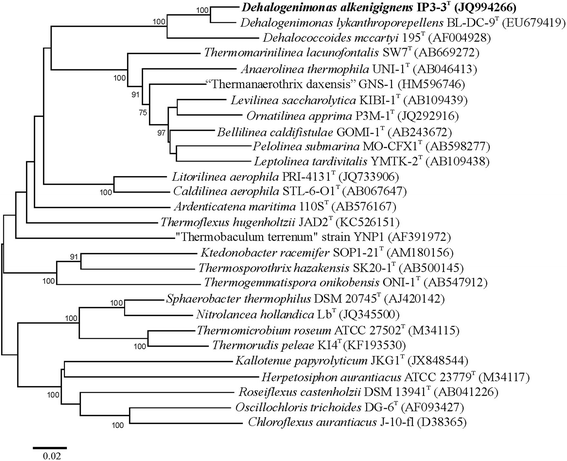Genome sequence of the organohalide-respiring Dehalogenimonas alkenigignens type strain (IP3-3(T))
- PMID: 27340512
- PMCID: PMC4918011
- DOI: 10.1186/s40793-016-0165-7
Genome sequence of the organohalide-respiring Dehalogenimonas alkenigignens type strain (IP3-3(T))
Abstract
Dehalogenimonas alkenigignens IP3-3(T) is a strictly anaerobic, mesophilic, Gram negative staining bacterium that grows by organohalide respiration, coupling the oxidation of H2 to the reductive dehalogenation of polychlorinated alkanes. Growth has not been observed with any non-polyhalogenated alkane electron acceptors. Here we describe the features of strain IP3-3(T) together with genome sequence information and its annotation. The 1,849,792 bp high-quality-draft genome contains 1936 predicted protein coding genes, 47 tRNA genes, a single large subunit rRNA (23S-5S) locus, and a single, orphan, small unit rRNA (16S) locus. The genome contains 29 predicted reductive dehalogenase genes, a large majority of which lack cognate genes encoding membrane anchoring proteins.
Keywords: 1,2,3-trichloropropane; 1,2-dichloroethane; 1,2-dichloropropane; Chloroflexi; Dehalococcoidia; Reductive dechlorination.
Figures



Similar articles
-
Dehalogenimonas etheniformans sp. nov., a formate-oxidizing, organohalide-respiring bacterium isolated from grape pomace.Int J Syst Evol Microbiol. 2023 May;73(5). doi: 10.1099/ijsem.0.005881. Int J Syst Evol Microbiol. 2023. PMID: 37185088
-
Complete genome sequence of Dehalogenimonas lykanthroporepellens type strain (BL-DC-9(T)) and comparison to "Dehalococcoides" strains.Stand Genomic Sci. 2012 May 25;6(2):251-64. doi: 10.4056/sigs.2806097. Epub 2012 May 15. Stand Genomic Sci. 2012. PMID: 22768368 Free PMC article.
-
Dehalogenimonas formicexedens sp. nov., a chlorinated alkane-respiring bacterium isolated from contaminated groundwater.Int J Syst Evol Microbiol. 2017 May;67(5):1366-1373. doi: 10.1099/ijsem.0.001819. Epub 2017 Jun 5. Int J Syst Evol Microbiol. 2017. PMID: 28126048
-
Genomic insights into organohalide respiration.Curr Opin Biotechnol. 2013 Jun;24(3):498-505. doi: 10.1016/j.copbio.2013.02.014. Epub 2013 Mar 13. Curr Opin Biotechnol. 2013. PMID: 23490446 Review.
-
Organohalide Respiring Bacteria and Reductive Dehalogenases: Key Tools in Organohalide Bioremediation.Front Microbiol. 2016 Mar 1;7:249. doi: 10.3389/fmicb.2016.00249. eCollection 2016. Front Microbiol. 2016. PMID: 26973626 Free PMC article. Review.
Cited by
-
Grape pomace compost harbors organohalide-respiring Dehalogenimonas species with novel reductive dehalogenase genes.ISME J. 2017 Dec;11(12):2767-2780. doi: 10.1038/ismej.2017.127. Epub 2017 Aug 15. ISME J. 2017. PMID: 28809851 Free PMC article.
-
Dehalogenation of Chlorinated Ethenes to Ethene by a Novel Isolate, "Candidatus Dehalogenimonas etheniformans".Appl Environ Microbiol. 2022 Jun 28;88(12):e0044322. doi: 10.1128/aem.00443-22. Epub 2022 Jun 8. Appl Environ Microbiol. 2022. PMID: 35674428 Free PMC article.
-
Genome Sequence, Proteome Profile, and Identification of a Multiprotein Reductive Dehalogenase Complex in Dehalogenimonas alkenigignens Strain BRE15M.J Proteome Res. 2021 Jan 1;20(1):613-623. doi: 10.1021/acs.jproteome.0c00569. Epub 2020 Oct 7. J Proteome Res. 2021. PMID: 32975419 Free PMC article.
-
Aerobic and anaerobic biodegradation of 1,2,3-trichloropropane and 1,2-dichloropropane: implications for bioremediation.Biodegradation. 2025 Sep 6;36(5):82. doi: 10.1007/s10532-025-10178-6. Biodegradation. 2025. PMID: 40913627
References
Publication types
LinkOut - more resources
Full Text Sources
Other Literature Sources
Molecular Biology Databases
Research Materials

